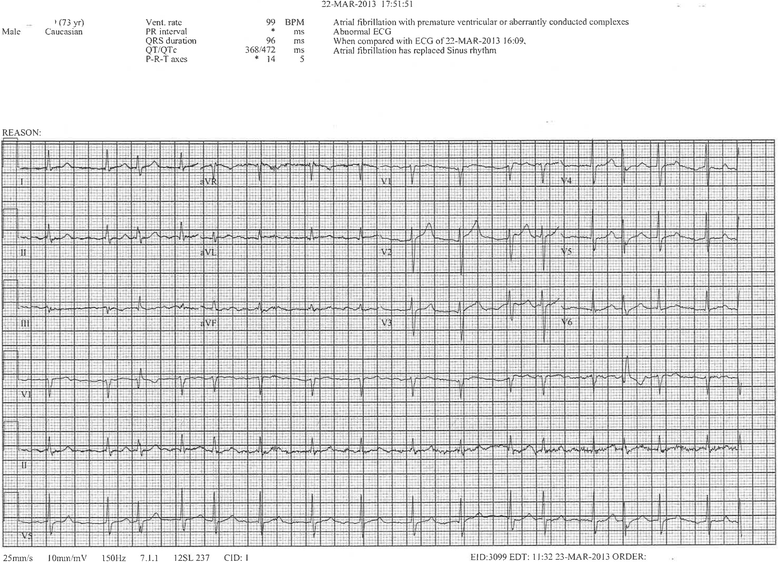Reversible atrial fibrillation following Crotalinae envenomation
- PMID: 28331489
- PMCID: PMC5359800
- DOI: 10.1186/s40409-017-0108-9
Reversible atrial fibrillation following Crotalinae envenomation
Abstract
Background: Cardiotoxicity is a documented complication of Crotalinae envenomation. Reported cardiac complications following snake envenomation have included acute myocardial infarction, electrocardiogram abnormalities and arrhythmias. Few reports exist describing arrhythmia induced by viper envenomation and to our knowledge none describe arrhythmia induced by Crotalinae envenomation. This report concerns the first known case of atrial fibrillation precipitated by rattlesnake bite.
Case presentation: A 73-year-old Caucasian man with a past medical history of hypertension, hyperlipidemia, type 1 diabetes mellitus, and a baseline first-degree atrioventricular block presented to the emergency department following a rattlesnake bite to his left lower leg. He developed pain and swelling in his left leg two-hour post-envenomation and subsequently received four vials of Crotalidae polyvalent immune fab (ovine). At three-hour post-envenomation following transfer to the intensive care unit, an electrocardiogram revealed new-onset atrial fibrillation. An amiodarone drip was started and the patient successfully converted to normal sinus rhythm approximately six hours after he was found to be in atrial fibrillation. A transthoracic echocardiogram revealed mild concentric left ventricular hypertrophy and an ejection fraction of 72%. He was discharged the following day with no hematological abnormalities and a baseline first-degree atrioventricular block.
Conclusion: This is the first documented case of reversible atrial fibrillation precipitated by Crotalinae envenomation. In patients with pertinent risk factors for developing atrial fibrillation, physicians should be aware of the potential for this arrhythmia. Direct toxic effects of venom or structural and electrophysiological cardiovascular abnormalities may predispose snakebite patients to arrhythmia, warranting extended and attentive cardiac monitoring.
Keywords: Atrial fibrillation; Bite; Crotalidae; Envenomation; Rattlesnake; Snakebite.
Figures
Similar articles
-
Pygmy rattlesnake envenomation treated with Crotalidae Polyvalent Immune Fab Antivenom.Toxicon. 2012 Dec 1;60(7):1287-9. doi: 10.1016/j.toxicon.2012.08.007. Epub 2012 Aug 30. Toxicon. 2012. PMID: 22963729
-
Atrial fibrillation caused by Daboia palestinae snakebite: a case report.Oxf Med Case Reports. 2023 Dec 19;2023(12):omad136. doi: 10.1093/omcr/omad136. eCollection 2023 Dec. Oxf Med Case Reports. 2023. PMID: 38145265 Free PMC article.
-
Continuous IV Crotalidae Polyvalent Immune Fab (Ovine) (FabAV) for selected North American rattlesnake bite patients.Toxicon. 2013 Jul;69:29-37. doi: 10.1016/j.toxicon.2013.02.008. Epub 2013 Mar 6. Toxicon. 2013. PMID: 23474267
-
Arrhythmias in the intensive care patient.Curr Opin Crit Care. 2003 Oct;9(5):345-55. doi: 10.1097/00075198-200310000-00003. Curr Opin Crit Care. 2003. PMID: 14508146 Review.
-
Does This Patient Have a Severe Snake Envenomation?: The Rational Clinical Examination Systematic Review.JAMA Surg. 2019 Apr 1;154(4):346-354. doi: 10.1001/jamasurg.2018.5069. JAMA Surg. 2019. PMID: 30758508
References
-
- Saadeh AM. Case report: acute myocardial infarction complicating a viper bite. Am J Trop Med Hyg. 2001;64(5–6):280–2. - PubMed
Publication types
LinkOut - more resources
Full Text Sources
Other Literature Sources
Miscellaneous



